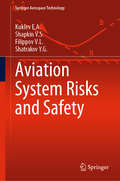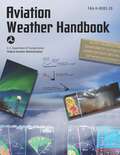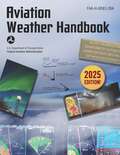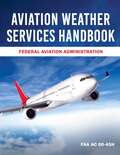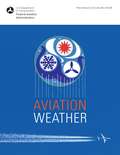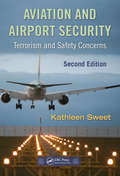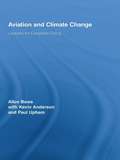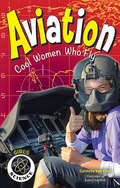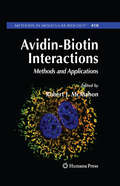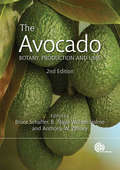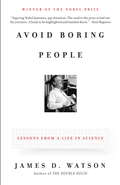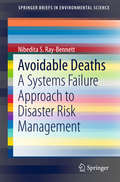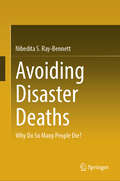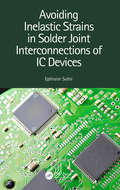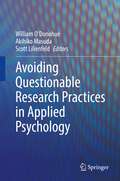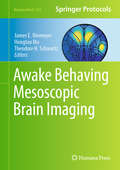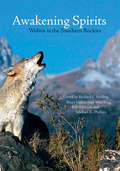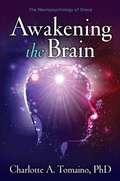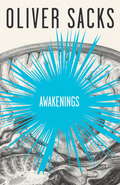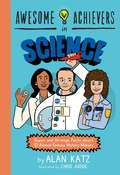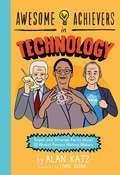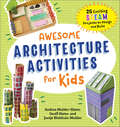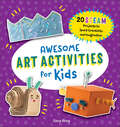- Table View
- List View
Aviation Noise Impact Management: Technologies, Regulations, and Societal Well-being in Europe
by Laurent Leylekian Alexandra Covrig Alena MaximovaThis open access book provides a view into the state-of-the-art research on aviation noise and related annoyance. The book will primarily focus on the achievements of the ANIMA project (Aviation Noise Impact Management through Novel Approaches), but not exclusively.The content has a broader theme in order to encompass. regulation issues, the ICAO (International Civil Aviation Organization) balanced approach, progresses made on technologies and reduction of noise at source, impact of possible future civil supersonic aircraft, land-use planning issues, as well as the core topics of the ANIMA project, i.e. impact on human beings, annoyance, quality of life, health and findings of the project in this respect.This book differs from traditional research programmes on aviation noise as the authors endeavour, not to lower noise at source, but to reduce the annoyance. This book examines these non-acoustic factors in an effort to help those most affected by aviation noise – communities living close to airports, and also help airport managers, policy-makers, local authorities and researchers to deal with this issue holistically. The book concludes with some recommendations for EU, national and local policy-makers, airport and aviation authorities, and more broadly a scientifically literate audience. These recommendations may help to identify gaps for progress in terms of research but also genuine implementation actions for political and regulatory authorities.
Aviation System Risks and Safety (Springer Aerospace Technology)
by Shatrakov Y.G. Kuklev E.A. Shapkin V.S. Filippov V.L.This book provides a solution to “rare event” problems without using the classical theory of reliability and theory of probability. This solution is based on the methodology of risk assessment as “measure of danger” (in keeping with the ICS RAS) and an expert approach to determining systems’ safety indications using Fuzzy Sets methods. Further, the book puts forward a new concept: “Reliability, Risks, and Safety” (RRS). The book’s main goal is to generalize present results and underscore the need to develop an alternative approach to safety level assessment and risk management for technical (aviation) systems in terms of Fuzzy Sets objects, in addition to traditional probabilistic safety analysis (PSA). The concept it proposes incorporates ICAO recommendations regarding proactive system control and the system’s responses to various internal and external disturbances.
Aviation Weather Handbook (2024): FAA-H-8083-28
by Federal Aviation AdministrationTHE ESSENTIAL FULL-COLOR WEATHER HANDBOOK FOR PILOTS! This handbook consolidates the weather information from six FAA weather-related advisory circulars (AC) into one useful publication. The following ACs will eventually be cancelled and replaced by this handbook: AC 00-06, Aviation Weather AC 00-24, Thunderstorms AC 00-30, Clear Air Turbulence Avoidance AC 00-45, Aviation Weather Services AC 00-54, Pilot Windshear Guide AC 00-57, Hazardous Mountain Winds The FAA designed Aviation Weather Handbook as a technical reference for all who operate in the National Aerospace System (NAS). Pilots, dispatchers, and operators will find this handbook a valuable resource for flight planning and decision making. With a complete guide to the United States' aviation weather program, products, and services, it also documents weather theory and its application to aviation. The objective of this handbook is to help the pilot and operator understand the basics of weather, aviation weather hazards, and aviation weather products. Beginners and advanced pilots alike will find the Aviation Weather Handbook to be a critical resource for all aviation weather subjects.
Aviation Weather Handbook (2025): FAA-H-8083-28A
by Federal Aviation AdministrationTHE ESSENTIAL FULL-COLOR WEATHER HANDBOOK FOR PILOTS IN 2025! This full-color handbook, released by the Federal Aviation Administration in December 2024, supersedes the first edition FAA-H-8083-28, Aviation Weather Handbook, dated 2022. This handbook consolidates the weather information from six FAA weather-related advisory circulars (AC) into one useful publication. The following ACs were canceled and replaced by this handbook: AC 00-06, Aviation Weather AC 00-24, Thunderstorms AC 00-30, Clear Air Turbulence Avoidance AC 00-45, Aviation Weather Services AC 00-54, Pilot Windshear Guide AC 00-57, Hazardous Mountain Winds The FAA designed Aviation Weather Handbook as a technical reference for all who operate in the National Aerospace System (NAS). Pilots, dispatchers, and operators will find this handbook a valuable resource for flight planning and decision making. With a complete guide to the United States' aviation weather program, products, and services, it also documents weather theory and its application to aviation. The objective of this handbook is to help the pilot and operator understand the basics of weather, aviation weather hazards, and aviation weather products. Beginners and advanced pilots alike will find the Aviation Weather Handbook to be a critical resource for all aviation weather subjects.
Aviation Weather Services Handbook: FAA AC 00-45H (Asa Faa Handbook Ser.)
by Federal Aviation AdministrationThis official handbook provides an authoritative weather tool for pilots, flight instructors, and those studying for pilot certification. From the Federal Aviation Administration with contributions from the National Weather Service and National Oceanic and Atmospheric Administration, this edition offers up-to-date information on the interpretation and usage of U.S. aviation weather products and services. Revised to take into account the phasing-out of some traditional weather products in favor of newer web-based tools, this newly organized guide can help pilots and operators use every available tool to plan safe and efficient flights. Color photographs, satellite images, diagrams, charts, and other illustrations enhance understanding of weather as it applies to flight and make this book an exhaustive resource no aviator or aeronautical buff should be without. Chapters included in the Aviation Weather Services Handbook are: Aviation Weather Service Program, Aviation Weather Product Policy, Observations, Analysis, Forecasts, and Aviation Weather Tools. Readers will also find useful appendices with definitions of common terms used in en route forecasts and advisories, a standard conversion chart, density altitude calculation, and a map of weather radar network sites. Educational, comprehensive, and potentially lifesaving, this is an indispensable manual for anyone involved in handling a plane.
Aviation Weather: FAA Advisory Circular (AC) 00-6B (FAA Handbooks Ser.)
by Federal Aviation AdministrationAviation Weather is a comprehensive resource for everything that pilots, students, and instructors need to know about navigating all types of weather safely. This book covers both visual (VMC) and instrument (IMC) meteorological conditions, and does so using detailed illustrations and diagrams. Subjects covered include the earth’s atmosphere, temperatures, atmospheric pressure and altimetry, wind, moisture, precipitation, clouds, air masses and fronts, turbulence, icing, thunderstorms, common IFR producers, high altitude weather, arctic and tropical weather, and soaring weather. A detailed glossary and index are provided for guidance.
Aviation and Airport Security: Terrorism and Safety Concerns, Second Edition
by Kathleen SweetThe Definitive Handbook on Terrorist Threats to Commercial Airline and Airport SecurityConsidered the definitive handbook on the terrorist threat to commercial airline and airport security, USAF Lieutenant Colonel Kathleen Sweet‘s seminal resource is now updated to include an analysis of modern day risks. She covers the history of aviation security
Aviation and Climate Change: Lessons for European Policy (Routledge Studies in Physical Geography and Environment #Vol. 8)
by Kevin Anderson Paul Upham Alice BowsIt is generally accepted – the US administration excepted - that the emissions reduction targets agreed in the Kyoto Protocol are only the beginning of what needs to be achieved in international climate negotiations. While studies suggest that major emission reductions by industrialized countries can be achieved at low economic cost, both these and early reductions by developing countries are inevitably a major political challenge. This book focuses on European policy toward climate change, specifically its ramifications for the aviation industry. With air travel predicted to grow enormously in the coming years, the issue of climate change is hugely topical for this important industry. Accessible to students, academics and practioners, this book is useful reading for all those with an interest in climate change, the aviation industry, or both.
Aviation: Cool Women Who Fly
by Carmella Van Vleet Lena ChandhokHave you ever looked up into the sky, seen an airplane, and wondered where it was going and who was flying it? Aviation is the study of the design, development and production, and operation of aircraft. In Aviation: Cool Women Who Fly, children ages 9 to 12 learn about this fascinating field and meet three successful women working in aviation. Meg Godlewski is a master certified flight instructor, Kristin Wolfe is a pilot in the Air Force, and Taylor McConnell is a production support engineer.Nomad Press books in the Girls in Science series supply a bridge between girls' interests and their potential futures by investigating science careers and introducing women who have succeeded in science. Compelling stories of real-life aviation experts provide readers with role models that they can look toward as examples of success.Aviation: Cool Women Who Fly uses engaging content, links to primary sources, and essential questions to whet kids' appetites for further exploration and study of aviation. This book explores the history of aviation, the women who helped pioneer flight, and the multitude of varied careers in this exciting and important field. Both boys and girls are encouraged to let their imaginations and dreams soar.
Avidin-Biotin Interactions: Methods and Applications (Methods in Molecular Biology #418)
by Robert J. McmahonThis book is specifically about the application of the extremely powerful interaction between the protein avidin or its homologues and the vitamin biotin and some of its homologues. With excellent descriptions of laboratory protocols written by expert researchers, this volume is equally perfect for the student or the professional laboratory scientist.
Avocado
by Peter Hofmann Richard Litz Anthony W Whiley Jonathan Crane André Ernst Carlos Balerdi Alejandro Barrientos Priego Mary Arpaia Ben Faber Rodrigo López-Gómez Uri Lavi Elizabeth Dann Andre Chanderbali Pilar Gil Lindy Coates Bruce Schaffer Mark Hoddle Edward Evans Derek Donkin Carol Lovatt Greg Douhan Emanuel Lahav Victor Albert John Bower Jay Bost Martín Aluja Lauren Garner Araceli Barceló-Muñoz Gary Bender B Nigel WolstenholmeAlthough avocado has been cultivated and consumed for more than 9000 years near its centre of origin in Latin America, world production and trade has increased dramatically over the past few decades. The avocado is now a widely traded fruit between warmer and colder countries as a result of the global community becoming increasingly aware of the versatility and nutritional value of this crop. For the past decade, the world avocado industry has been going through a period of rapid technological change and innovation. The dietary value of "the most nutritious of all fruit" is also receiving more attention. This fully updated new edition of the successful 2002 book will provide a comprehensive review of avocado production, science and technology.
Avoid Boring People: Lessons from a Life in Science
by James D. WatsonFrom a living legend--James D. Watson, who shared the Nobel Prize for having revealed the structure of DNA--a personal account of the making of a scientist. In Avoid Boring People, the man who discovered "the secret of life" shares the less revolutionary secrets he has found to getting along and getting ahead in a competitive world. Recounting the years of his own formation--from his father's birding lessons to the political cat's cradle of professorship at Harvard--Watson illuminates the progress of an exemplary scientific life, both his own pursuit of knowledge and how he learns to nurture fledgling scientists. Each phase of his experience yields a wealth of age-specific practical advice. For instance, when young, never be the brightest person in the room or bring more than one date on a ski trip; later in life, always accept with grace when your request for funding is denied, and--for goodness' sake--don't dye your hair. There are precepts that few others would find occasion to heed (expect to gain weight after you win your Nobel Prize, as everyone will invite you to dinner) and many more with broader application (do not succumb to the seductions of golf if you intend to stay young professionally). And whatever the season or the occasion: avoid boring people. A true believer in the intellectual promise of youth, Watson offers specific pointers to beginning scientists about choosing the projects that will shape their careers, the supreme importance of collegiality, and dealing with competitors within the same institution, even one who is a former mentor. Finally he addresses himself to the role and needs of science at large universities in the context of discussing the unceremonious departure of Harvard's president Larry Summers and the search for his successor. Scorning political correctness, this irreverent romp through Watson's life and learning is an indispensable guide to anyone plotting a career in science (or most anything else), a primer addressed both to the next generation and those who are entrusted with their minds.
Avoidable Deaths
by Nibedita S. Ray-BennettThis book addresses one of the most fundamental questions of the 21st century: why deaths continue to occur in natural disasters despite the tremendous advancements in disaster management science and weather forecasting systems, increased sophistication of human-built environments and ongoing economic and policy development worldwide. By presenting an interdisciplinary tool for analysing ‘systems failure’, the book provides concrete suggestions on how deaths may be reduced in resource-poor contexts. It goes beyond traditional risk and vulnerability perspectives and demonstrates that deaths in disasters are complex problems that can be solved by adopting a socio-technical perspective to improve current disaster management systems in the developing world. The book is a timely contribution, as it directly addresses Global Target One of the UN’s ‘Sendai Framework for Disaster Risk Reduction’, which has urged 185 UN Member States to reduce disaster mortality by 2030. Further, it offers a valuable resource for students, researchers, policy-makers and practitioners interested in disaster risk reduction, human rights, gender, sociology of risk, crisis and disasters, environmental science, organisation and management studies.
Avoiding Disaster Deaths: Why Do So Many People Die?
by Nibedita S. Ray-BennettThis book introduces a pathbreaking approach called &‘Avoidable Disaster Deaths&’ (ADD) to reduce disaster deaths. Disaster deaths are the direct and indirect impact of hazards. The &‘Sendai Framework for Disaster Risk Reduction&’ has urged the United Nations Member States to reduce disaster deaths or mortality by 2030. Reducing the number of disaster deaths has become a useful marker for improving disaster risk management. Equally important is knowing how people die, who dies, why they die, and which disaster deaths are &‘avoidable&’ and &‘unavoidable&’. Disaster risk reduction specialists have not fully examined these questions. Built from disaster risk reduction, public health, epidemiology, human geography, risk and crisis management studies, the ADD approach disaggregates disaster deaths into avoidable and unavoidable. Avoidable disaster deaths are preventable, amenable and governance-related. Unavoidable deaths are those that occur annually due to natural causes or poverty-related diseases. In a disaster climate, the emphasis should be on reducing avoidable disaster deaths in a resource-constrained context. Using the context of COVID-19 and the economic lockdown in India, the analytical advantage of this approach is explored. Doing so, the book brings forth human stories whose lives were cut short and introduces novel matrices and dynamic strategies to ascertain the &‘cause and circumstances&’ of avoidable disaster deaths to develop the capacity of disaster and health responders. The book is suitable for students, academics, policy-makers and practitioners interested in disaster risk reduction, human rights, risk and crisis management, environmental science, human geography, Sustainable Development and Sendai Goals. The book is also suitable for passionate citizens who want to capture the number, causes and circumstances of avoidable disaster deaths and take positive action to save lives in their communities. Professor Nibedita S. Ray-Bennett ably presents a novel &‘avoidable disaster deaths&’ approach to disaster risk reduction and management by presenting cogent arguments rooted in solid theory and up to date literature reviews, complemented by a wealth of data and analysis from the Indian Covid 19 experience. The book includes a range of tables and diagrams that crystallise approaches and practices useful for policy makers and practitioners alike. The book is highly informed, well written, accessible, practical and useful, with an optimal mix of strong, well-tested academic theory, and important recommendations that demand serious consideration by all involved and interested in disasters. A spur to action and inspiration. (Professor Michael Petterson, School of Social Sciences, Auckland University of Technology, New Zealand)
Avoiding Inelastic Strains in Solder Joint Interconnections of IC Devices
by Ephraim SuhirAvoiding Inelastic Strains in Solder Joint Interconnections of IC Devices addresses analytical (mathematical) modeling approaches aimed at understanding the underlying physics and mechanics of the behavior and performance of solder materials and solder joint interconnections of IC devices. The emphasis is on design for reliability, including probabilistic predictions of the solder lifetime. Describes how to use the developed methods of analytical predictive modeling to minimize thermal stresses and strains in solder joint of IC devices Shows how to build the preprocessing models in finite-element analyses (FEA) by comparing the FEA and analytical data Covers how to design the most effective test vehicles for testing solder joints Details how to design and organize, in addition to or sometimes even instead of highly accelerated life tests (HALT), highly focused and highly cost-effective failure oriented accelerated testing (FOAT) to understand the physic of failure of solder joint interconnections Outlines how to convert the low cycle fatigue conditions into elastic fatigue conditions and to assess the fatigue lifetime in such cases Illustrates ways to replace time- and labor-consuming, expensive, and possibly misleading temperature cycling tests with simpler and physically meaningful accelerated tests This book is aimed towards professionals in electronic and photonic packaging, electronic and optical materials, materials engineering, and mechanical design.
Avoiding Questionable Research Practices in Applied Psychology
by Scott Lilienfeld Akihiko Masuda William O’DonohueThis authoritative volume presents a detailed analysis of the replication crisis and the use of questionable research practices (QRPs) in psychology, as well as recommended practices for combatting these problems. Ultimately, the book aims to provide a comprehensive, current, and accessible account of the adverse effects of QRPs.The replication crisis in psychology and allied fields has exposed critical flaws in the standard views of research methods, which allow for extensive flexibility in data analysis by investigators and permit the widespread use of QRPs. Chapters examine the intentional use of QRPs such as data fabrication and falsification, along with subtler, unintentional practices such as p-hacking and HARKING (hypothesizing after results are known). Drawing on the growing awareness of these problems, contributors also highlight potential strategies to detect QRPs and minimize their negative impact through open data practices, preregistration of hypotheses and analyses, and adversarial collaborations, in which investigators holding opposing positions on a scientific issue agree to work together on a study in an effort to counteract their respective biases. Among the topics covered:History of controversies in statistics and replicationEmbracing intellectual humility while designing researchConfirmatory vs. exploratory analysesPublication bias and negative resultsPromoting honest and transparent report writingAvoiding Questionable Research Practices in Applied Psychology provides a deeper understanding of how QRPs impede the reliability and trustworthiness of findings in psychology and the social sciences. It will be a practical, useful resource for students and instructors in graduate and advanced undergraduate level research methods classes, along with psychological researchers interested in improving their own research.
Awake Behaving Mesoscopic Brain Imaging (Neuromethods #214)
by Hongtao Ma Theodore H. Schwartz James E. NiemeyerThis volume explores the latest techniques used to study how mesoscale imaging can be applied in various areas of neuroscientific research. The chapters in this book are organized into four parts: Part One highlights novel imaging modalities, such as neurotransmitter and single-cell resolution imaging and analyses of neuroimaging data in awake rodents. Part Two covers technical innovations such as head-mounted camera systems, multi-site photometry, and concurrent imaging-electrographic probes. Part Three presents methods of mesoscale imaging during normal behavior, and Part Four looks at the mesoscale imaging methods used to study neurological diseases and disorders that are critical to observe in the non-anesthetized condition. In the Neuromethods series style, chapters include the kind of detail and key advice from the specialists needed to get successful results in your laboratory. Cutting-edge and thorough, Awake Behaving Mesoscopic Brain Imaging is a valuable resource for both novice and expert researchers who are interested in learning more about this exciting and innovative topic.
Awakening Spirits: Wolves in the Southern Rockies
by Michael Phillips Brian Miller Richard P. Reading Rob Edwards Amy L. MaschingThis illustrated collection offers fascinating insight on restoring the wolf population to the southern Rockies. Detailed reports by wildlife biologists, geographers, legal and policy experts, and conservationists provide a comprehensive look at not only the ecological imperatives, but also the history, legal framework, and public attitudes affecting the future of wolves.
Awakening the Brain
by Charlotte A TomainoHuman potential cannot be quantified. The more we learn about the brain, the more hidden promise we unearth. What if you could harness the full spectrum of your abilities by engaging your brain in such a way to expand your awareness and broaden your skill sets? Through simple exercises and insights, you can increase your capacity to learn and fundamentally change the way your brain functions. In Awakening the Brain, Dr. Charlotte A. Tomaino reveals how the way you think and what you believe can actually awaken your brain and expand your consciousness. You'll learn how to: * read your Brain-Body Compass to make positive choices; * alleviate stress to keep your brain in its optimal arousal state; * focus your mind to guide your thoughts and emotions; * connect with the inherent strength of your intuition; and * engage the full power of your thoughts and beliefs. Microsoft Tags throughout the book link to free explanatory videos for those who want more information. Wake up to your true potential!lains the basic workings of the brain in direct, simple language. No science classes required. In addition, Microsoft tags throughout the book link to free explanatory videos to enhance the experience for those who want more.he way our consciousness interprets our experience How ancient spiritual practices have been shown to affect the brain How you can train the neural networks in you brain to create a shift in your own consciousness How enlightenment is literally a physical state of mind How you can design and build your own divine mind and achieve a life of spiritual connection To further enhance the reading experience, Microsoft tags appear throughout the text, which link you to videos that dig even deeper into this fascinating subject.
Awakening the Brain: The Neuropsychology of Grace
by Charlotte A. TomainoHuman potential cannot be quantified. The more we learn about the brain, the more hidden promise we unearth. What if you could harness the full spectrum of your abilities by engaging your brain in such a way to expand your awareness and broaden your skill sets? Through simple exercises and insights, you can increase your capacity to learn and fundamentally change the way your brain functions. In Awakening the Brain, Dr. Charlotte A. Tomaino reveals how the way you think and what you believe can actually awaken your brain and expand your consciousness. You'll learn how to: * read your Brain-Body Compass to make positive choices; * alleviate stress to keep your brain in its optimal arousal state; * focus your mind to guide your thoughts and emotions; * connect with the inherent strength of your intuition; and * engage the full power of your thoughts and beliefs. Microsoft Tags throughout the book link to free explanatory videos for those who want more information. Wake up to your true potential!
Awakenings
by Oliver SacksAwakenings -- which inspired the major motion picture -- is the remarkable story of a group of patients who contracted sleeping-sickness during the great epidemic just after World War I. Frozen for decades in a trance-like state, these men and women were given up as hopeless until 1969, when Dr. Oliver Sacks gave them the then-new drug L-DOPA, which had an astonishing, explosive, "awakening" effect. Dr. Sacks recounts the moving case histories of his patients, their lives, and the extraordinary transformations which went with their reintroduction to a changed world.From the Trade Paperback edition.
Awesome Achievers in Science: Super and Strange Facts about 12 Almost Famous History Makers (Awesome Achievers #2)
by Alan Katz Chris JudgePart of a super fun middle grade series, Awesome Achievers in Science puts the spotlight on lesser-known heroes and their contributions in major scientific fields.Everyone has heard the names Neil Armstrong and Buzz Aldrin, but what about Michael Collins--the third brave Apollo 11 astronaut who didn't get to walk on the moon? Many of the most relevant figures in scientific history have remained in the shadows, but not any longer! From Alan Katz's new Awesome Achievers series, Awesome Achievers in Science gives kids a look behind the scenes at 12 lesser-known scientists whose contributions are personally relevant to their lives today. Each figure is given a traditional biography but is also subject to Katz's unique brand of silliness, with humorous elements such as imagined poems, song lyrics, and diary entries by or about the not-so-famous figure accompanying each bio. Spot illustrations throughout add to the lighthearted and appreciative humor each figure receives. Reluctant readers and budding scientists alike will delight in this imaginative and engaging continuation of a new series of laugh-out-loud biographies.
Awesome Achievers in Technology: Super and Strange Facts about 12 Almost Famous History Makers (Awesome Achievers)
by Alan Katz Chris JudgePart of a super fun middle grade series, Awesome Achievers in Technology puts the spotlight on lesser-known heroes and their contributions in tech.Everyone has heard the name Steve Jobs, but what about Nolan Bushnell--Jobs's boss before the invention of Apple, and the founder of the first major video game, Pong? Many of the most relevant figures in tech history have remained in the shadows, but not any longer! From Alan Katz's new Awesome Achievers series, Awesome Achievers in Technology gives kids a look behind the scenes at 12 lesser-known inventors whose contributions to tech are personally relevant to their lives today. Each figure is given a traditional biography but is also subject to Katz's unique brand of silliness, with humorous elements such as imagined poems, song lyrics, and diary entries by and about the not-so-famous figure accompanying each bio. Spot illustrations throughout add to the lighthearted and appreciative humor each figure receives. Reluctant readers and budding tech enthusiasts alike will delight in this imaginative and engaging introduction to a new series of laugh out loud biographies.
Awesome Architecture Activities for Kids: 25 Exciting STEAM Projects to Design and Build (Awesome STEAM Activities for Kids)
by Andrea Mulder-Slater Jantje Blokhuis-Mulder Geoff SlaterGet kids excited about architecture with hands-on activities for ages 5 to 10Architects create the spaces we use every day—but how do they know what a building should look like? Kids will uncover the answer with this book of 25 at-home architecture activities! Inside, they'll explore the key principles of building and design through creative projects like constructing a bridge, designing a garden, and planning a shopping center.Architecture and engineering books for kids like this one can help kids develop their problem-solving skills as they answer questions about each activity and take notes on what they learn. Best of all, the projects get more challenging as the book progresses, encouraging kids to apply their new knowledge to the next activities. Kid-friendly instructions—Step-by-step guidance and illustrations make these projects easy for kids to do with minimal supervision.No special equipment required—These projects use inexpensive everyday items like blankets, popsicle sticks, and tin cans, so kids can get started right away.See the STEAM connection—Discover how each architecture activity fits into the world of science, technology, engineering, art, and math.Encourage kids to see the world around them in a new way with this book of architecture for kids!
Awesome Art Activities for Kids: 20 STEAM Projects to Spark Creativity and Imagination (Awesome STEAM Activities for Kids)
by Lucy SongSpark creativity with hands-on art projects for kids ages 5 to 10 The world is full of art! From paintings in museums to beautiful buildings, we see art everywhere we go. Get kids excited about making art themselves with this book of projects that inspires them to think like an artist and shows them how much fun it is to create with their own hands.They'll learn about the history of art and all kinds of different mediums, before diving into 20 super fun activities. With each one, they'll experience art in action—and the science behind it—as they make their own stamps, illustrate the life cycle of a butterfly with found objects, and draw with food coloring and salt. Animate young imaginations with a book that helps kids build the skills they need to think outside the box.Go beyond other art books for kids with:A STEAM connection—Explore a range of art techniques and find out how they relate to science, technology, engineering, and math.Kid-friendly instructions—Step-by-step guidance and helpful photos make these projects easy to follow and simple enough for kids to do with minimal supervision.Basic materials—Every activity in this art book for kids can be made with inexpensive, familiar items that you probably have at home.Unlock the world of art and science with this activity book for kids that helps them learn and grow.

